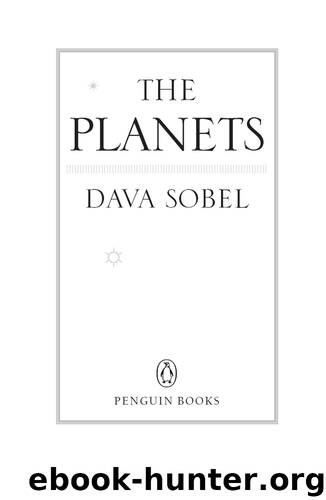The Planets by Dava Sobel

Author:Dava Sobel [Sobel, Dava]
Language: eng
Format: epub
ISBN: 9781101659489
Publisher: Penguin Group US
Published: 2006-10-30T16:00:00+00:00
The uniqueness of the on-site vantage point empowered the Galileo probe to overturn long-accepted theories by its every discovery. Likewise the things it failed to find caused consternation and conjecture throughout the planetary science community, as when water turned up missing from the returned data.
Astronomers had predicted that the probe, after piercing the visible, colorful ammonia cloud level, would fall through a thick lower layer of ice- and water-laden clouds, where it could be rained on, even struck by lightning. Classical astrologers had also characterized Jupiter as “moist,” in a medieval medical system that claimed the various planets’ hot, cold, moist, and dry qualities influenced human health by shifting the balance among the four bodily humors—blood, phlegm, and black and yellow bile. Moist Jupiter, holding sway over the blood, also inspired the “sanguine” temperament in individuals, making Jupiterians generally cheerful, or “jovial,” as opposed to mercurial, martial, or saturnine.
Contrary to all expectations, the Galileo probe had by chance encountered a dry area, entering a rare hot spot—one of those breaks in the clouds where Jupiter’s heat escapes into space. In time, however, the Galileo orbiter, mother ship to the probe, photographed titanic lightning bolts a thousand times brighter than Earthly discharges, and confirmed the presence of atmospheric water vapor. Indeed, outside the hot-spot “deserts” that continually shift their locations around Jupiter, many parts of the atmosphere appear saturated with water.
The orbiter portion of the Galileo spacecraft went on to explore the Jovian system for seven years. Unlike the probe, which made only a quick diagnostic descent into Jupiter, the orbiter became a long-lived artificial companion to the Galilean satellites.
Galileo took commands from mission controllers at the Jet Propulsion Laboratory in southern California, who periodically fired the spacecraft’s rocket engine to adjust its orbit, sending it now close in toward Jupiter to visit Europa, now out on a wide loop to fly by distant Callisto. As Galileo navigated among the Galilean moons, it discerned the defining characteristic of each: Nearby Io, the reddest, most volcanic body known; Europa, host to an ice-capped salt water ocean; Ganymede, the Solar System’s largest satellite; Callisto, one of the most primitive and pummeled ones.*
Just as the planetary alignments in a horoscope limn the possibilities of a life, so the relative positions of these moons have determined their destiny. Io, the nearest, exhibits the trauma of a too-close attachment. Jupiter’s gravitational pull has racked Io with tidal stress, keeping its interior permanently melted, so that fire fountains of lava spew unceasingly from some one hundred fifty active volcanoes.
Europa, the next nearest to Jupiter and the smallest of the Galilean satellites, also shows signs of internal heating by tidal stress. But the material melted on Europa has apparently been ice, not rock. Thanks to Galileo, many scientists now believe a salty sea, more voluminous than the Atlantic and Pacific together, lies sandwiched between Europa’s frozen surface and its rocky depths, and moreover that its waters might support some form of extraterrestrial life.
Ganymede, though larger than the planet Mercury and farther from Jupiter than Io or Europa, also endures tidal stress.
Download
This site does not store any files on its server. We only index and link to content provided by other sites. Please contact the content providers to delete copyright contents if any and email us, we'll remove relevant links or contents immediately.
Tools of Titans by Timothy Ferriss(8218)
Turbulence by E. J. Noyes(7936)
Secrets of Antigravity Propulsion: Tesla, UFOs, and Classified Aerospace Technology by Ph.D. Paul A. Laviolette(5309)
Astrophysics for People in a Hurry by Neil DeGrasse Tyson(5133)
Room 212 by Kate Stewart(5037)
Design of Trajectory Optimization Approach for Space Maneuver Vehicle Skip Entry Problems by Runqi Chai & Al Savvaris & Antonios Tsourdos & Senchun Chai(5011)
Pale Blue Dot by Carl Sagan(4912)
The David Icke Guide to the Global Conspiracy (and how to end it) by David Icke(4625)
A Journey Through Divination and Astronomy by Publishing Pottermore(4344)
Goodbye Paradise(3727)
Apollo 8 by Jeffrey Kluger(3637)
COSMOS by Carl Sagan(3554)
Losing the Nobel Prize by Brian Keating(3499)
The Five People You Meet in Heaven by Mitch Albom(3475)
How to Read Water: Clues and Patterns from Puddles to the Sea (Natural Navigation) by Tristan Gooley(3408)
Brief Answers to the Big Questions by Stephen Hawking(3369)
How to Read Nature by Tristan Gooley(3249)
The Order of Time by Carlo Rovelli(3145)
A Brief History of Time by Stephen Hawking(2960)
